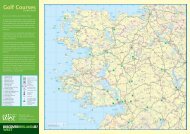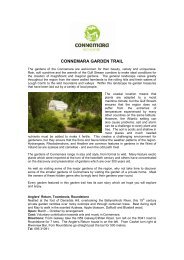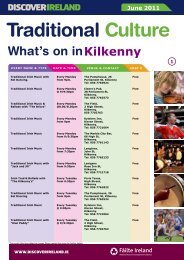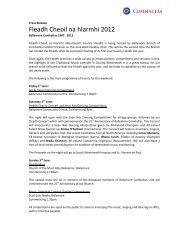Boyne Valley brochure [pdf, 8.03MB] - Discover Ireland
Boyne Valley brochure [pdf, 8.03MB] - Discover Ireland
Boyne Valley brochure [pdf, 8.03MB] - Discover Ireland
Create successful ePaper yourself
Turn your PDF publications into a flip-book with our unique Google optimized e-Paper software.
Mellifont Abbey<br />
Mellifont Abbey was one of the wealthiest<br />
and most influential monastic houses in<br />
medieval <strong>Ireland</strong><br />
Mellifont Abbey is situated in a tranquil valley on the banks of the<br />
River Mattock, a tributary of the River <strong>Boyne</strong>. The Abbey derives<br />
its name from the Latin Font Mellis meaning ‘fountain of honey’.<br />
Many medieval monasteries founded by continental orders bore<br />
Latin names. Mellifont is the only one that survives as a current<br />
placename in <strong>Ireland</strong>.<br />
St. Malachy, Archbishop of Armagh, along<br />
with a community of Irish and French monks<br />
(trained at Clairvaux, Burgundy), founded<br />
Mellifont Abbey in 1142 on lands granted<br />
by Donogh O’Carroll, King of Oriel. It was<br />
the first Cistercian monastery established in<br />
<strong>Ireland</strong> and over 20 other Cistercian houses<br />
were founded directly or indirectly from it.<br />
Mellifont also became one of the wealthiest<br />
abbeys in <strong>Ireland</strong> with vast holdings of land<br />
in the fertile <strong>Boyne</strong> <strong>Valley</strong>.<br />
The Abbey was consecrated in 1157 amidst<br />
great ceremony at a national synod, which<br />
was attended by the leading clergy of the<br />
time and Murtaugh MacLochlainn, the<br />
36 FOR MORE INFORMATION GO TO WWW.BOYNEVALLEYDRIVE.IE<br />
High King of <strong>Ireland</strong>. Mellifont heralded<br />
a new era in Irish monasticism. Prior to<br />
its foundation, older Irish monasteries<br />
(such as Monasterboice) were essentially<br />
independent self-governed spiritual centres,<br />
under the direction of an Abbott who was<br />
largely his own master. These older monastic<br />
sites were often not affiliated to any other<br />
monastery or even to any religious order.<br />
Mellifont was dissolved in 1539 and passed<br />
into the hands of Sir Edward Moore who<br />
converted the abbey buildings into a<br />
residence. In 1603, following Irish defeat<br />
at the Battle of Kinsale, Hugh O’ Neill, the<br />
Earl of Tyrone, formally submitted to Lord<br />
Mountjoy at Mellifont Abbey signing the<br />
Treaty of Mellifont. This sounded the death<br />
knell for Gaelic civilisation in <strong>Ireland</strong>. During<br />
the Battle of the <strong>Boyne</strong> in 1690 King William<br />
based his headquarters at Mellifont. The<br />
house was abandoned and fell into disrepair<br />
in the early 1700s.<br />
Although the remains of the Abbey are<br />
fragmentary, Mellifont is historically and<br />
architecturally significant. It was the first<br />
abbey in <strong>Ireland</strong> to be laid out according<br />
to the European cloistral plan – buildings<br />
constructed around a central open space.<br />
Its distinguishing feature is an octagonal<br />
lavabo, constructed about 1200, which<br />
functioned as a place for the monks to<br />
wash their hands in a symbolic gesture as<br />
a preparation for prayer. Lavabo means ‘I<br />
shall wash’. The lavabo, the chapter house<br />
and the late medieval gate house remain<br />
partly intact. The layout of the remainder<br />
of the abbey can be seen from foundations<br />
revealed during excavations.<br />
Did you know? Devorgilla (often described as<br />
‘<strong>Ireland</strong>’s Helen of Troy’), whose elopement<br />
with Dermot MacMurrough led to the arrival<br />
of the Anglo-Normans in 1169 is buried<br />
beneath the chancel pavement at Mellifont.<br />
In 1157 she donated 60 ounces of gold,<br />
along with altar cloths and a gold chalice to<br />
Mellifont. She died there in 1193 at the age<br />
of 85.<br />
Contact Details:<br />
Old Mellifont Abbey, Tullyallen,<br />
Drogheda, Co. Louth<br />
T: +353 (0)41 9826459<br />
F: +353 (0)41 9826053<br />
E: mellifontabbey@opw.ie<br />
W: www.heritageireland.ie<br />
GPS: 53.74281, -6.465561<br />
FOR OPENING TIMES AND ADMISSION DETAILS PLEASE SEE PULL OUT INSERT AT THE BACK 37


![Boyne Valley brochure [pdf, 8.03MB] - Discover Ireland](https://img.yumpu.com/13306944/38/500x640/boyne-valley-brochure-pdf-803mb-discover-ireland.jpg)














